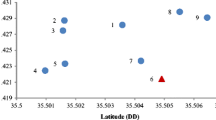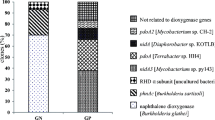Abstract
In this study, 28 hydrocarbon-degrading bacterial isolates from oil-contaminated Antarctic soils were screened for the presence of biodegradative genes such as alkane hydroxylase (alks), the ISPα subunit of naphthalene dioxygenase (ndoB), catechol 2,3-dioxygenase (C23DO) and toluene/biphenyl dioxygenase (todC1/bphA1) by using polymerase chain reaction (PCR) methods. All naphthalene degrading bacterial isolates exhibited the presence of a 648 bp amplicon that shared 97% identity to a known ndoB sequence from Pseudomonas putida. Twenty-two out of the twenty-eight isolates screened were positive for one, two or all three different regions of the C23DO gene. For alkane hydroxylase, all 6 Rhodococcus isolates were PCR-positive for a 194 bp and a 552 bp segment of the alkB gene, but exhibited variable results with primers located at different segments of this gene. Three Pseudomonas spp. 4/101, 19/1, 30/3 amplified 552 bp segment of alkB. Only two Pseudomonas sp. 7/156 and 4/101 amplified a segment of alkB exhibiting 89–94% nucleotide sequence identity with the existing sequence of alkB in the GenBank sequence database. Transcripts of three genes, alkB2, C23DO and ndoB, that were amplified by DNA-PCR in three different bacterial isolates also exhibited positive amplification by reverse transcriptase PCR (RT-PCR) method confirming that these genes are functional. A competitive PCR (cPCR) method was developed for a quantitative estimation of ndoB from pure cultures of the naphthalene-degrading Pseudomonas sp. 30/2. A minimum of 1x107 copies of the ndoB gene was detected based on the comparison of the intensities of the competitor and target DNA bands. It is expected that the identification and characterization of the biodegradative genes will provide a better understanding of the catabolic pathways in Antarctic psychrotolerant bacteria, and thereby help support bioremediation strategies for oil-contaminated Antarctic soils.



Similar content being viewed by others
References
Aislabie J, McLeod M, Fraser R (1998) Potential for biodegradation of hydrocarbons in soil from the Ross dependency, Antarctica. Appl Microbiol Biotechnol 49:210–214
Aislabie J, Balks M, Astori N, Stevenson G, Symons R (1999) Polycyclic aromatic hydrocarbons in fuel-oil contaminated soils, Antarctica. Chemosphere 39:2201–2207
Aislabie J, Foght J, Saul DJ (2000) Aromatic-hydrocarbon degrading bacteria isolated from soil near Scott Base, Antarctica. Polar Biol 23:183–188
Aislabie JM, Balks MR, Foght JM, Waterhouse EJ (2004) Hydrocarbon spills on Antarctic soils: effects and management. Environ Sci Technol 38:1265–1274
Aislabie J, Saul DJ, Foght JM (2006) Bioremediation of hydrocarbon-contaminated polar soils. Extremophiles 10:171–179
Ausubel FM, Brent R, Kingston RE, Moore DD, Smith JG, Sideman JG, Struhl K (eds) (1987) Current protocols in molecular biology. John Wiley & Sons, Inc., New York, pp 2.10–2.11
Atlas RM (1981) Microbial degradation of petroleum hydrocarbons: an environmental perspective. Microbiol Rev 45:180–209
Baraniecki CA, Aislabie J, Foght JM (2002) Characterization of Sphingomonas sp. Ant 17, an aromatic hydrocarbon-degrading bacterium isolated from Antarctic soil. Microb Ecol 43:44–54
Bej AK, Saul DJ, Aislabie J (2000) Cold tolerance of alkane-degrading bacteria isolated from soil near Scott Base, Antarctica. Polar Biol 23:100–105
Campbell IB, Claridge GGC, Campbell DI, Balks MR (1998) The soil environment of the McMurdo Dry Valleys, Antarctica. In: Priscu JC (ed) Ecosystem dynamics in a polar desert. The McMurdo Dry Valleys, Antarctica, American Geophysical Union, Washington, D.C., pp 61–76
Celi FS, Zenilman ME, Shuldiner AR (1993) A rapid and versatile method to synthesize internal standards for competitive PCR. Nucleic Acids Res 21:1047
Cerniglia CE (1984) Microbial metabolism of polycyclic aromatic hydrocarbons. Adv Appl Microbiol 30:31–71
Chandler DP, Brockman FJ (1996) Estimating biodegradative gene numbers at a JP-5 contaminated sites using PCR. Appl Biochem Biotechnol 57–58:971–982
Cowan DA, Tow LA (2004) Endangered Antarctic environments. Annu Rev Microbiol 58:649–690
Dean-Ross D (1993) Fate of Jet fuel JP-4 in soil. Bull Environ Contam Toxicol 51:596–599
Dean-Ross D, Mayfield H, Spain J (1992) Environmental fate and effects of Jet fuel JP8. Chemosphere 24:219–228
Ebinghaus R (2008) Mercury cycling in the Arctic—does enhanced deposition flux mean net-input. Environ Chem 5:87–88
Ellis LBM, Roe D, Wackett LP (2006) The University of Minnesota Biocatalysis/biodegradation database: the first decade. Nucleic Acids Res 34:D517–D521
Eltis LD, Bolin JT (1996) Evolutionary relationships among extradiol dioxygenases. J Bacteriol 178:5930–5937
Ensminger JT, McCold LN, Webb JW (1999) Environmental impact assessment under the national environmental policy act and the protocol on environmental protection to the Antarctic treaty. Environ Manage 24:13–23
Eriksson M, Sodersten E, Yu Z, Dalhammar G, Mohn WW (2003) Degradation of polycyclic aromatic hydrocarbons at low temperature under aerobic and nitrate-reducing conditions in enrichment cultures from northern soils. Appl Environ Microbiol 69:275–284
Ferrero M, Llobet-Brossa E, Lalucat J, García-Valdés E, Rosselló-Mora R, Bosch R (2002) Coexistence of two distinct copies of naphthalene degradation genes in Pseudomonas strains isolated from the western Mediterranean region. Appl Environ Microbiol 68:957–962
Furukawa K, Arimura N (1987) Purification and properties of 2,3-dihydroxybiphenyl dioxygenase from polychlorinated biphenyl-degrading Pseudomonas pseudoalcaligenes and Pseudomonas aeruginosa carrying the cloned bphC gene. J Bacteriol 169:924–927
Head IM, Jones DM, Roling WF (2006) Marine microorganisms make a meal of oil. Nat Rev Microbiol 4:173–182
Heider J, Spormann AM, Beller HR, Widdel F (1999) Anaerobic bacterial metabolism of hydrocarbons. FEMS Microbiol Rev 22:459–473
Herrick JB, Stuart-Keil KG, Ghiorse WC, Madsen EL (1997) Natural horizontal transfer of a naphthalene dioxygenase gene between bacteria native to a coal tar-contaminated field site. Appl Environ Microbiol 63:2330–2337
Ka JO, Yu Z, Mohn WW (2001) Monitoring the size and metabolic activity of the bacterial community during biostimulation of fuel-contaminated soil using competitive PCR and RT-PCR. Microb Ecol 42:267–273
Kerry E (1993) Bioremediation of experimental petroleum spills on mineral soils in the Vestfold Hills, Antarctica. Polar Biol 13:163–170
Kok M, Oldenhuis R, van der Linden MP, Raatjes P, Kingma J, van Lelyveld PH, Witholt B (1989) The Pseudomonas oleovorans alkane hydroxylase gene. Sequence and expression. J Biol Chem 264:5435–5441
Kuhn E, Bellicanta GV, Pellizari VH (2009) New alk genes detected in Antarctic marine sediments. Environ Microbiol 11:669–673
Kurkela S, Lehvaslaiho H, Palva ET, Teeri TH (1988) Cloning, nucleotide sequence and characterization of genes encoding naphthalene dioxygenase of Pseudomonas putida strain NCIB9816. Gene 73:355–362
Laramee L, Lawrence JR, Greer CW (2000) Molecular analysis and development of 16S rRNA oligonucleotide probes to characterize a diclofop-methyl-degrading biofilm consortium. Can J Microbiol 46:133–142
Lo Giudice A , Casella P, Caruso C, Mangano S, De Domenico M, Michaud L (2009) Occurrence and characterization of psychrotolerant 1 hydrocarbon-oxidizing bacteria from surface seawater along the Victoria Land coast (Antarctica). Polar Biol (in review)
Martin-Laurent F, Piutti S, Hallet S, Wagschal I, Philippot L, Catroux G, Soulas G (2003) Monitoring of atrazine treatment on soil bacterial, fungal and atrazine-degrading communities by quantitative competitive PCR. Pest Manag Sci 59:259–268
Mesarch MB, Nakatsu CH, Nies L (2000) Development of catechol 2,3-dioxygenase-specific primers for monitoring bioremediation by competitive quantitative PCR. Appl Environ Microbiol 66:678–683
Michaud L, Di Cello F, Brilli M, Fani R, Lo Giudice A, Bruni V (2004a) Biodiversity of cultivable psychrotrophic marine bacteria isolated from Terra Nova Bay (Ross Sea, Antarctica). FEMS Microbiol Lett 230:63–71
Michaud L, Lo Giudice A, Saitta M, De Domenico M, Bruni V (2004b) The biodegradation efficiency on diesel oil by two psychrotrophic Antarctic marine bacteria during a two-month-long experiment. Mar Poll Bull 49:405–409
Nakai C, Kagamiyama H, Nozaki M, Nakazawa T, Inouye S, Ebina Y, Nakazawa A (1983) Complete nucleotide sequence of the metapyrocatechase gene on the TOI plasmid of Pseudomonas putida mt-2. J Biol Chem 258:2923–2928
Oger C, Berthe T, Quillet L, Barray S, Chiffoleau JF, Petit F (2001) Estimation of the abundance of the cadmium resistance gene cadA in microbial communities in polluted estuary water. Res Microbiol 152:671–678
Panicker G, Aislabie J, Saul D, Bej AK (2001) Cold tolerance of Pseudomonas sp. 30–3 isolated from oil-contaminated soil, Antarctica. Polar Biol 25:5–11
Phillips CJ, Paul EA, Prosser JI (2000) Quantitative analysis of ammonia oxidizing bacteria using competitive PCR. FEMS Microbiol Ecol 32:167–175
Ratajczak A, Geidorfer W, Hillen W (1998) Alkane hydroxylase from Acinetobacter sp. strain ADP-1 is encoded by alkM and belongs to a new family of bacterial integral-membrane hydrocarbon hydroxylases. Appl Environ Microbiol 64:1175–1179
Rehm HJ, Reiff I (1981) Mechanisms and occurrence of microbial oxidation of long-chain alkanes. Adv Biochem Eng 19:175–215
Saul DJ, Aislabie JM, Brown CE, Harris L, Foght JM (2005) Hydrocarbon contamination changes the bacterial diversity of soil from around Scott Base, Antarctica. FEMS Microbiol Ecol 53:141–155
Smits TH, Rothlisberger M, Witholt B, van Beilen JB (1999) Molecular screening for alkane hydroxylase genes in Gram-negative and Gram-positive strains. Environ Microbiol 1:307–317
Smits TH, Balada SB, Witholt B, van Beilen JB (2002) Functional analysis of alkane hydroxylases from gram-negative and gram-positive bacteria. J Bacteriol 184:1733–1742
Sotsky JB, Greer CW, Atlas RM (1994) Frequency of genes in aromatic and aliphatic hydrocarbon biodegradation pathways within bacterial populations from Alaskan sediments. Can J Microbiol 40:981–985
Stapleton RD, Sayler GS (1998) Assessment of the microbiological potential for the natural attenuation of petroleum hydrocarbons in a shallow aquifer system. Microb Ecol 36:349–361
van Beilen JB, Funhoff EG (2007) Alkane hydroxylases involved in microbial alkane degradation. Appl Microbiol Biotechnol 74:13–21
van Beilen JB, Wubbolts MG, Witholt B (1994) Genetics of alkane oxidation by Pseudomonas oleovorans. Biodegradation 5:161–174
van Beilen JB, Smits TH, Whyte LG, Schorcht S, Rothlisberger M, Plaggemeier T, Engesser KH, Witholt B (2002) Alkane hydroxylase homologues in Gram-positive strains. Environ Microbiol 4:676–682
Vomberg A, Klinner U (2000) Distribution of alkB genes within n-alkane-degrading bacteria. J Appl Microbiol 89:339–348
Wasmund K, Burns KA, Kurtböke DI, Bourne DG (2009) Novel alkane hydroxylase gene (alkB) diversity in sediments associated with hydrocarbon seeps in the Timor Sea, Australia. Appl Environ Microbiol 75:7391–7398
Whyte LG, Greer CW, Inniss WE (1996) Assessment of the biodegradation potential of psychrotrophic microorganisms. Can J Microbiol 42:99–106
Whyte LG, Bourbonniere L, Greer CW (1997) Biodegradation of petroleum hydrocarbons by psychotropic Pseudomonas strains possessing both alkane (alk) and naphthalene (nah) catabolic pathways. Appl Environ Microbiol 63:3719–3723
Whyte LG, Hawari J, Zhou E, Bourbonniere L, Inniss WE, Greer CW (1998) Biodegradation of variable-chain-length alkanes at low temperatures by a psychrotrophic Rhodococcus sp. Appl Environ Microbiol 64:2578–2584
Whyte LG, Bourbonniere L, Bellrose C, Greer CW (1999a) Bioremediation assessment of hydrocarbon-contaminated soils from the high Arctic. Bioremed J 3:69–79
Whyte LG, Slagman SJ, Pietrantonio F, Bourbonnere L, Koval SF, Lawrence JR, Innis WE, Greer CW (1999b) Physiological adaptations involved in alkane assimilation at a low temperature by Rhodococcus sp. Strain Q15. Appl Environ Microbiol 65:2961–2968
Whyte LG, Smits TH, Labbé D, Witholt B, Greer CW, van Beilen JB (2002a) Gene cloning and characterization of multiple alkane hydroxylase systems in Rhodococcus strains Q15 and NRRL B-16531. Appl Environ Microbiol 68:5933–5942
Whyte LG, Schultz A, van Bielen JB, Luz AP, Pellizari V, Labbe D, Greer CW (2002b) Prevalence of alkane monooxygenase genes in Arctic and Antarctic hydrocarbon—contaminated and pristine soils. FEMS Microbiol Ecol 41:141–150
Wilson MS, Herrick JB, Jeon CO, Hinman DE, Madsen EL (2003) Horizontal transfer of phnAc dioxygenase genes within one of two phenotypically and genotypically distinctive naphthalene-degrading guilds from adjacent soil environments. Appl Environ Microbiol 69:2172–2181
Zeiger E, Smith L (1998) The first international conference on the environmental health and safety of Jet fuel. Environ Health Perspect 106:763–764
Zylstra GJ, Gibson DT (1989) Toluene degradation by Pseudomonas putida F1. Nucleotide sequence of the todC1C2BADE genes and their expression in Escherichia coli. J Biol Chem 264:14940–14946
Acknowledgments
This work was supported in part by funding from the Foundation of Research, Science and Technology, New Zealand (C09X0018) and the Faculty Development Award to A. Bej, University of Alabama at Birmingham, Alabama, USA. Logistic support was provided by Antarctic New Zealand.
Conflict of interest
The authors declare that they have no conflict of interest.
Author information
Authors and Affiliations
Corresponding author
Additional information
Equal effort by the authors Gitika Panicker and Nazia Mojib.
Rights and permissions
About this article
Cite this article
Panicker, G., Mojib, N., Aislabie, J. et al. Detection, expression and quantitation of the biodegradative genes in Antarctic microorganisms using PCR. Antonie van Leeuwenhoek 97, 275–287 (2010). https://doi.org/10.1007/s10482-009-9408-6
Received:
Accepted:
Published:
Issue Date:
DOI: https://doi.org/10.1007/s10482-009-9408-6




